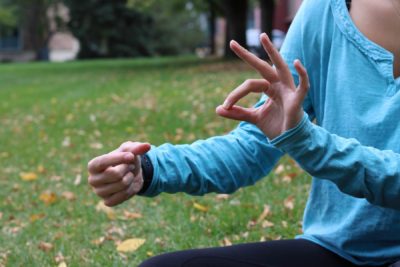As appearing in The Collegian
The Department of Languages, Literatures and Cultures is working to create an American Sign Language minor at Colorado State University in the near future.
Currently, four semester-long ASL courses are offered at CSU. In fall 2017, two more ASL courses will be added to the program: Advanced Study of Deafness in ASL: Cultural and Linguistic Perspectives; and American Sign Language and Linguistics for the Pre-Professional.

The push to create an ASL minor at the University came after Cai Hopkins, a former student and current CSU alumnus, and Michelle Moyer, senior zoology major and current president of the Colostate Sign Club, wrote feasibility reports on adding ASL as a minor to the language department for their final projects in JTC 300. Hopkins and Moyer reported “a lot of student interest” in the minor after conducting their research, Moyer said.
Deanne Seitz, an ASL instructor at CSU, used the research done by Hopkins and Moyer to advocate to the dean of the Department of Languages, Literatures and Cultures for the creation of an ASL minor.
Although the proposal received widespread support from students and faculty members, a lot of work still needs to be done before the minor can be created, Moyer said.
“The department is supporting this effort, aware of student interest, aware of faculty interest…but it’s going to be a couple more years down the road,” Moyer said.
In order to introduce a minor into this department, the ASL program requires upper-division culture classes that match other language programs. The two new courses that will be offered next fall will help fulfill that requirement.
In the past five years, the number of ASL class sections offered at CSU has increased. In 2011, there were only two sections of ASL I and one section of ASL II. Now, the department offers four sections of ASL I, two sections of ASL II, and one section of ASL III and ASL IV, Seitz said.
Increased student interest in studying ASL at CSU mirrors national trends. Between 2009 and 2013, the Modern Language Association reported that the number of students enrolled in ASL courses increased by 19 percent nationally, Seitz said.
“(CSU students are) extremely passionate about ASL and the deaf community,” Seitz said. “Once they go beyond the first semester… they want to drink in as much as they can about deaf culture.”
As a supplement to these academic courses, students can also to join the Colostate Sign Club. The club hosts deaf socials that put on activities like silent diners, deaf theater and bowling in Greeley, Hopkins said.
“In this, you’re learning about a whole sector of people you don’t know anything about,” Hopkins said.
Moyer, who has studied ASL for the past five years, said that she enjoys learning the language because it is unique.
“ASL is a very different kind of language because not only is it manual, using your hands, you can learn non-verbal communication techniques…it actually uses more of your left brain…you can incorporate more skills that you weren’t aware you had,” Moyer said.
Moyer also said that studying ASL helps people reconsider their preconceptions about deafness.
“Most of the deaf people I’ve met don’t see themselves as disabled,” Moyer said. “They’re just different, and different is never wrong. Just because they aren’t identical to us doesn’t mean that they are somehow broken and need to be fixed.”
Hopkins said that learning about the history of prejudice associated with deaf culture encouraged her to advocate for this community.
“You don’t have to be LGBTQ to advocate for those rights, you don’t have to be deaf to advocate for deaf rights,” Hopkins said.
Brian Edwards, sociology major with a concentration in criminology and criminal justice, said that learning ASL has helped him gain a greater understanding of deaf culture and an appreciation of languages. Edwards attends the ASL service offered at Cross Roads Church.
“We should embrace deaf culture more and not treat it as an impairment because, as one of the church members says, ‘I am not impaired…you are because you can’t read sign language,’” Edwards said.
Alex Forseth, senior psychology major, said there is a great value to learning ASL,
“Sign language is an actual language,” Forseth said. “A lot of people think it is random hand signs. No, it isn’t. Is has a structure.”
Forseth also said that he has enjoyed taking ASL classes at CSU and would encourage others to learn more about this language by looking into the program and getting involved.
“It’s a great language, just at least try it.”
